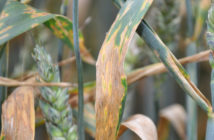With very early indications emerging about potential crop sizes for harvest 2015, it appears that for barley, we’re facing another tight global supply situation in the season ahead. The latest forecast from the International Grains Council (IGC) suggests that barley production could decline by 4% in 2015/16, after contracting by 3% this season compared with 2013/14.
Even though global consumption is also forecast to dip in 2015/16, we’ve just had two years of growth in barley demand (by 7% between 2012/13 and 2014/15). So coupled with another year of lower output expectations, demand is predicted to exceed output (Figure 1).This leaves the global barley market exposed to the risk of output disruptions, meaning that international prices could react more unpredictably to shifts in supply.
For brewers and maltsters, premature yeast flocculation (PYF) causes a significant headache in the form of financial and logistical problems with industrial production. PYF results in clumping together of yeast too early in the brewing process, before the wort sugars are fully fermented. This can result in lower alcohol volumes, flavour abnormalities, disrupted production times and a loss of yeast available for re-use in subsequent fermentations. The likely cause of PYF is fungi which infect either barley in the field or malt in the maltings, or both. In partnership with the University of Nottingham, HGCA funded a three-year PhD studentship study investigating PYF, its impact upon fermentation and methods for detection.
On 6 May, HGCA’s Winchester Monitor Farm group looked at spring barley management. Monitor farmer Ian Cammack and farm manager Andy Bason grow Propino spring barley, and at this meeting explored factors affecting yield. This followed a winter meeting with HGCA’s Susannah Bolton which identified potential barriers to raising yields.
During the meeting, the group reviewed different strategies now being implemented to raise yields, including headland management, P and K management, and variable rate seeding. The report from the session will be available on hgca.com/winchester.
The summer open day at this Monitor Farm will be on 1 July 2015. For more information contact HGCA Regional Manager Philip Dolbear, philip.dolbear@ahdb.org.uk or call 07964 255614.
This year, there are 24 winter barley and 20 spring barley varieties on display, and as usual, there are tours of the barley recommended list plots at the following times: Wednesday 10 June, 10:00, 13:00 and 15:30 and Thursday 11 June, 10:00 and 13:30
With fungicide plots for barley, wheat and oilseed rape, visitors to the event can also discuss our independent trials results with leading experts so they can make more appropriate fungicide choices to minimise resistance risks and environmental impact. By visiting the barley plots, you can:
– Ask how adverse weather over the last few seasons has challenged disease control and tested the mettle of fungicides – both ‘old’ and ‘new’.
– Discuss how newer SDHI chemistry can offer broad-spectrum improvements in disease control
– Find out about established and emerging fungicide resistance threats.
– Learn how to combine products effectively to reduce over-reliance on one particular chemical group.
Last year’s UK barley harvest totalled 6.911Mt, leaving an estimated 2 million tonnes available for export. So far this season (July-December) barley exports have totalled 743Kt, equating to 11% of the 2014 crop of which over a third has been shipped to non-EU destinations.
Sarah Mann, HGCA Exports Manager said: “UK grain exports have had to focus on non-EU destinations this season as a result of an over-supplied EU grains market and the strength of the Sterling against the Euro. With another record breaking surplus of barley this year, it is good to see UK barley growers gaining benefit from this market demand.There are only a small number of ports in the UK capable of supplying vessels of the size required by markets such as Saudi. Understanding the requirements of your local port by attending an event such as Meet the Exporter is so important when making key decisions on the farm.”



